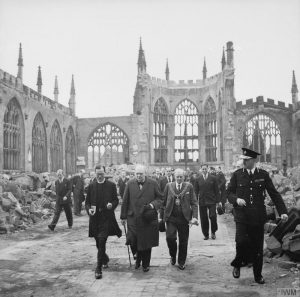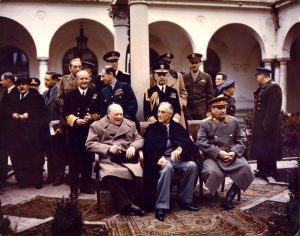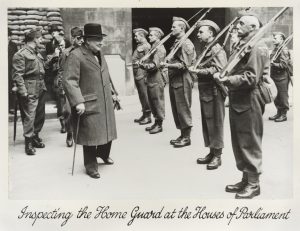
Finest Hour 173
Books, Arts, & Curiosities – Leader of the Pack
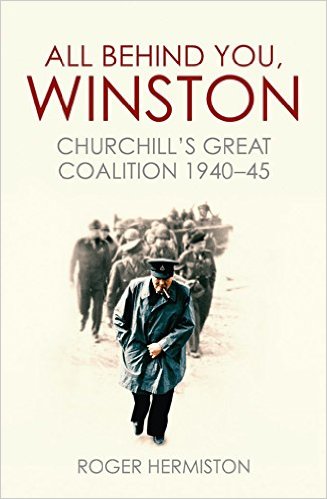
August 14, 2016
Finest Hour 173, Summer 2016
Page 38
Roger Hermiston, All Behind You, Winston: Churchill’s Great Coalition, 1940–45, Aurum Press, 406 pages, £20.
ISBN 978–1781313312
Review by John Campbell
John Campbell’s books include major biographies of F. E. Smith, Aneurin Bevan, Edward Heath, Margaret Thatcher, and most recently Roy Jenkins.

2025 International Churchill Conference
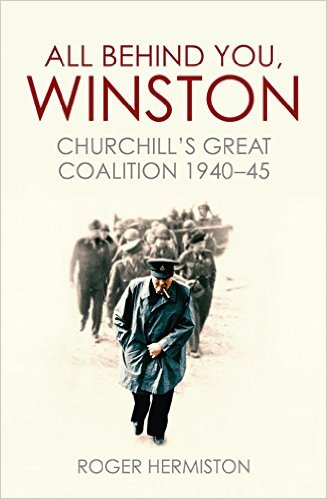 The title of this book derives from the caption for the great cartoonist David Low’s Evening Standard drawing of 14 May 1940—four days after Churchill became Prime Minister— showing Churchill followed by leaders of the new government, all rolling up their sleeves and marching determinedly forward to start the job of winning the war.
The title of this book derives from the caption for the great cartoonist David Low’s Evening Standard drawing of 14 May 1940—four days after Churchill became Prime Minister— showing Churchill followed by leaders of the new government, all rolling up their sleeves and marching determinedly forward to start the job of winning the war.
Roger Hermiston’s bright idea is to take this image as the starting point for examining Britain’s war effort not as the achievement of one man—however indispensable his leadership—but rather as the product of the whole coalition government, comprising a remarkable collection of individuals from widely different backgrounds, working together, not always harmoniously but in the end effectively, for the common goal of victory. It is so obviously right that it is surprising that no one, so far as I know, has done it before. His book is skilfully constructed, with successive chapters focussing on the particular contribution of different players while maintaining a broad chronological narrative through the stages of the war, from the defiant unity of May 1940 through the dark days of 1941 to the turning of the tide in 1942 with the entry of the Russians and the Americans and the increasing strains within the coalition, as attention turned towards building the post-war world.
While Churchill was almost wholly taken up with military strategy, it was his colleagues who had to keep the forces supplied with manpower, weapons, and equipment and keep the nation fed and safe. The key figures were Ernest Bevin, the roughhewn leader of the Transport and General Workers Union, whose appointment as Minister of Labour was the most striking symbol of national unity overcoming pre-war class antagonism; Herbert Morrison, Labour leader of the London County Council, who became Home Secretary with responsibility for protecting the populations of London and other cities from the effects of German bombing, as well as addressing sensitive questions of civil liberty in wartime; and the maverick Canadian newspaper proprietor Lord Beaverbrook, an old crony of Churchill’s who was initially put in charge of galvanising aircraft production in 1940–41 and later given a number of other tasks in which he repeatedly clashed with Bevin and Morrison but could usually rely on Churchill’s support.
As Minister of Food Lord Woolton—originally plain Fred Marquis, a successful Liverpool businessman—organised the “kitchen front,” which enabled the country to survive the real threat of starvation by German U-boats. Woolton earned the affectionate nickname “Uncle Fred” while imposing increasingly severe rationing and promoting spartan dietary expedients like Woolton Pie (“steak and kidney pie without the steak and kidney”).
Brendan Bracken, another unconventional protege of the prime minister, made a success of the tricky job of Minister of Information, which had earlier defeated the more distinguished John Reith and Duff Cooper, winning the trust of the newspapers and the BBC by giving them news instead of suppressing it. Among other unsung heroes, Hermiston also highlights the vital contribution of the only two women in the government: the Labour firebrand “Red Ellen” Wilkinson in the Home Office and the formidable Tory Florence Horsbrugh, who combined effectively with Morrison and Sir John Anderson to organise civil defence, provide bomb shelters, and look after the victims of bombing in London and all the other heavily-targeted cities around the country.
Curiously, the one character who still does not fully come to life is the ever-elusive Clement Attlee—the man who as deputy Prime Minister really ran the government, resolved disputes and held the coalition together while Churchill was preoccupied with the war, uninterested in domestic matters and frequently absent. Many colleagues testified to the quiet efficiency of Attlee’s chairmanship, compared with Churchill’s magnificent but often rambling monologues; but it is still not clear exactly how he exerted his unassuming authority. A rare glimpse is provided by a sharp letter he wrote Churchill in early 1945 protesting at his failure to read the papers before Cabinet:
More and more often you have not even read the note prepared for your guidance. Often half an hour or more is wasted in explaining what could have been grasped by two or three minutes reading of the document.
Churchill was said to be furious; but Clementine admired Attlee’s courage, and he eventually sent a chastened reply.
The sometimes tense relationships within the coalition make a good new slant on a familiar story, and Roger Hermiston tells it well.
Subscribe
WANT MORE?
Get the Churchill Bulletin delivered to your inbox once a month.

